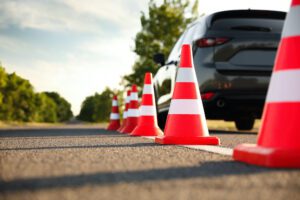What Should You Do When Moving Off From Behind a Parked Car?

What Should You Do When Moving Off From Behind a Parked Car?
You might get this question in your driving theory test:
What should you do when moving off from behind a parked car?
a) Use your signals after moving off.
b) Look around after moving off.
c) Check only your exterior mirrors.
d) Check both your interior and exterior mirrors.
When you think about it, this one’s really easy! The answer’s (d), of course: When moving off from behind a parked car, you should check both your interior and exterior mirrors.
Moving Off From Behind a Parked Car – What Not to Do
Options (a) and (b) are clearly wrong. Why would you only use your signals after moving off? The whole point of using your signals is to let other drivers know what you’re about to do, not to remind other drivers of something you’re already doing.
Similarly, it makes no sense to look around after moving off. Obviously, you should always check it’s safe to move before pulling out.
Option (c) is also clearly wrong. Your car has both internal and external mirrors to let you see as much of your surroundings as possible. There is no reason at all why you’d only use your exterior mirrors. Use all of them to check that it’s safe to move off – that’s what they’re there for!
So the answer can only be (d) – when moving off from behind a parked car, check both your interior and exterior mirrors.
But even this answer misses a very important step that you should always take before you move off from behind a parked car: check your blind spot!
How to Move Off From Behind a Parked Car – Step-by-Step
Use all mirrors to check if the road’s clear. Check both your interior and your exterior mirrors.
Check your blind spot. The blind spot is an area behind your car that’s not visible in your mirrors. Before moving off, quickly look over your shoulder to make sure there’s nothing in your blind spot. Be particularly wary of cyclists, motorcyclists, and pedestrians.
Signal away from the kerb. It’s a good idea to signal even if there’s nobody else around. That way, if any vehicles approach while you’re moving out, they’ll know what you’re doing, and they should either slow down or stop to let you out. Never assume a car behind you is going to stop, though, even if they have seen you.
Make one final check. Having looked around and signalled, make one final check before you move out, including one last look at your blind spot. It’s the only way to make sure!
And that’s it! Once you’ve made sure it’s safe to move out, and after you’ve let other drivers know that you’re about to pull out, then it should be safe to move.
How to get out of a tight parking space
If you’re in a tight parking space – You might have to do some slight manoeuvres before you can move out of the space. While doing this, signal away from the kerb. That way, other drivers will know that you’re planning on moving out. Otherwise, they might presume that you’re just trying to park. And again, don’t assume that any approaching cars will stop for you. If necessary, wait until the coast is clear before you move out.
Pulling out onto a fast road
If you’re on a busy road, accelerate quickly after pulling away from the kerb to match the speed of the traffic. Otherwise, you could present a hazard to any fast moving vehicles behind you.
After you move off, look forward
Before you move off, you need to pay attention to the road behind you, to ensure it’s safe to emerge. But once you’ve moved away from the kerb, you should immediately start paying attention to the road ahead of you. Conditions can change quickly!
More Guides for Learner Drivers
We’ve got loads of guides to help you pass both your theory and your practical test. Take a look at these for starters:
Finally, if you want to pass your test first time, it pays to get some practice in outside of lessons. This’ll really help you to build up your confidence behind the wheel. You’ll need someone to supervise you, though. Head here to read our guide to who can supervise learner drivers.
You’ll also need some learner driver insurance to cover you for any driving you do outside of your lessons. At Go Girl, we specialise in affordable cover for learner drivers. Head here to get a quote online in minutes.






